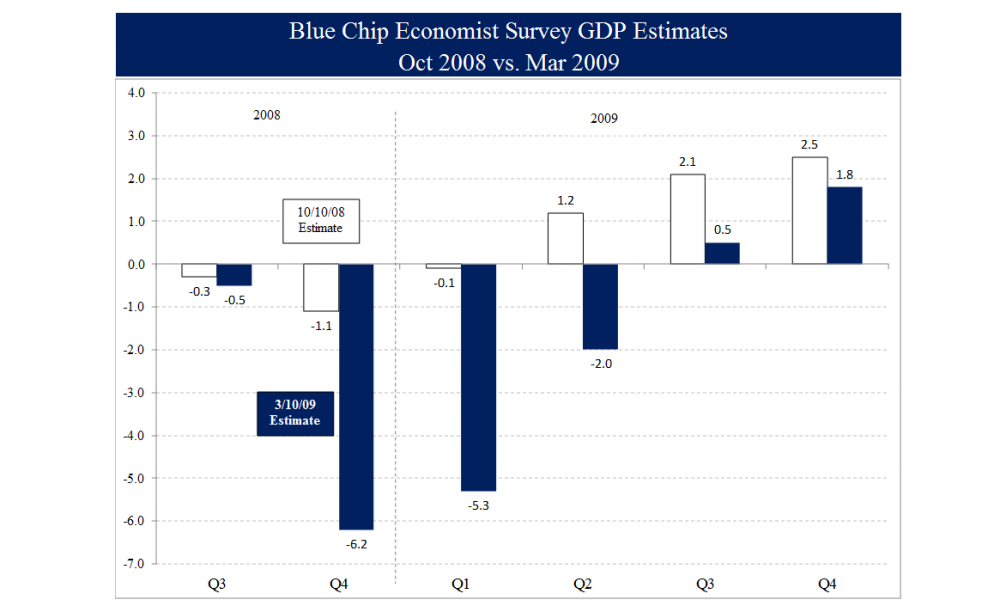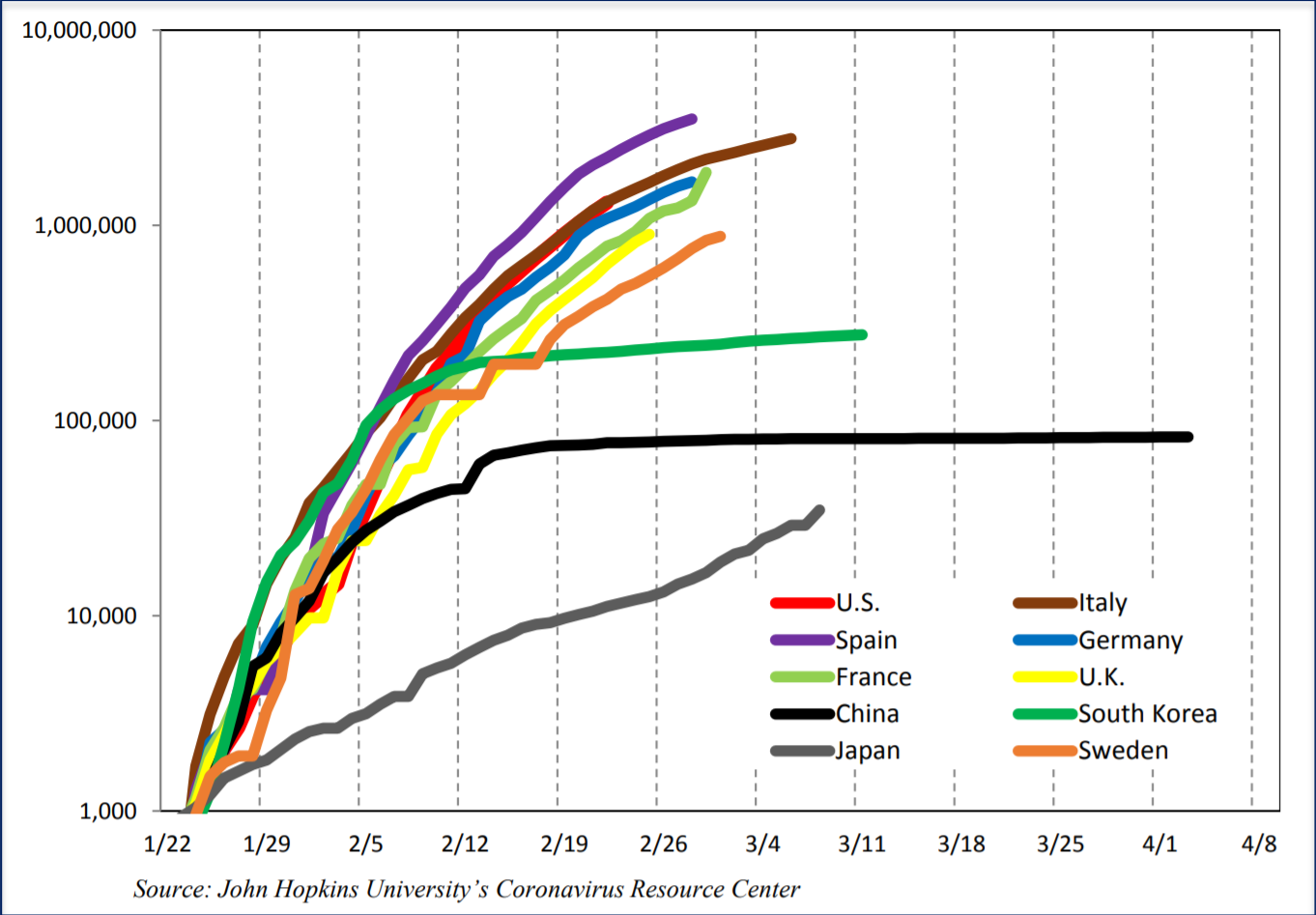Stating the Obvious: The Economy is Weak
April was an historic month for the country, the markets, and the economy. We cannot predict how the pandemic will play out, but we continue to track the data and evidence of progress such as U.S. hospitals are no longer overwhelmed by COVID-19 cases. In an apparent contradiction, April economic releases confirmed that the economy was extremely weak, but the S&P 500 rallied 12.7% in April — the 3rd biggest monthly move since 1950 behind January 1987 and October 1974. This month we will discuss the pandemic, the economy, the Federal Reserve, the stock market, and the
implications going forward. Downside equity risk remains, but we are encouraged by a mix of more positive signs. As a result, the U.S., developed and emerging markets equity ratings are neutral at a rating of 3. Long-term bonds are negative at a 2 rating. The Gold rating remains a bullish 5 and commodities are neutral at 3.
COVID-19 Pandemic in the U.S.: Testing Rising, New Cases Steady
We are watching tracking cases of COVID-19 on a daily basis for trends in the pandemic. Social distancing, government mandated closures, and quarantines were successful in holding new daily cases in a 25,000-35,000 per day range, but as you can see new daily cases are not declining. We are also watching testing which is just starting to move higher. As the U.S. and other countries reopen their economies, the trend in new cases will determine how fast it can proceed, and how quickly the economy might recover. Hospital capacity is also a key measure states will be monitoring on how fast to proceed. In the meantime, we will watch our time-tested indicators for implications.
Chart 1:U.S. COVID-19 New Tests vs. New Cases
Stating the Obvious: The Economy is Weak
The ISM manufacturing index for April was 41.5, the weakest reading since 2009, and in the worst 5% of readings since 1990. Several other indicators like unemployment claims, confidence and other regional purchasing managers indices were similar, following the first quarter GDP reading of -4.8%. These confirmed what we already suspected, that certain sectors of the U.S. economy were at a standstill in April. Consensus GDP estimates of -24.5% for the second quarter. The ISM index is one of the best coincident economic indicators because it is released with no time lag and is rarely revised. Since equities decline ahead of economic weakness, low ISM readings can occur near or even after the low point of equity bear markets like those low readings in 1974, 1980 and 1990. However, low readings were bullish for stocks only if the economy was close to a rebound. In other cases when low readings were followed by more low readings, stocks continued lower. For instance, in the 1981-82 recession, the ISM first reached 40 in October 1981, but stocks continued to decline for 9 months until August 1982. That’s why the economic outlook indicators are so important to determine the implications for stocks.
Chart 2:ISM Index 41.5: Bullish for Stocks if Rebound Ahead

Chart 3:Industry Revenues vs. Same Week in 2019: Not All Industries Are Down

Economic Outlook: Weak but Improving
Our Economic Outlook Indicators are still weak at 35, however they improved by 7 points since April 2nd as equity indices and commodities like copper rallied while high-yield interest rates fell. As economies open, we will watch several activity measures like public transportation usage and the Apple mobility trends which track people’s activity. These are already showing an upward trend in April. As these improve, the reaction in the number of new cases and economic outlook indicators will be important. If mobility and economic outlook indicators continue their improvement, it will increase the odds the economy can at least slow the decline and even turn higher at some point. However, if the number of new cases and hospitalizations surge, it will add to the risk of a new shut down and extended economic weakness.
Chart 4:Economic Outlook Weak but Improving: Potential Economic Turning Point

Chart 5: Changes in Mobility Trends in the United States since 1/13/20

Crash Pattern: Consolidation
Last month we wrote about the consolidation phase typical after sharp equity declines and rebounds. A typical crash pattern is driven by human emotion. Excessive fear and pessimism in a crash is followed by a relief rally driven by hope, which then gives way to a more realistic level in between. So far the S&P 500 has followed this pattern with the 33% S&P 500 decline ending on March 23rd followed by a 31% rally through April 29th. Last month the odds were good for a reversion to the downside. However, you can see this year’s rally went further than prior cases, perhaps due to the unprecedented Fed stimulus and the potential reopening of world economies. The size and duration of the rally may be significant and have more positive implications at this point.
Chart 6: S&P 500 30% Declines: 12 Prior Cases 1928-2020

S&P 500 30% Rallies: Positive
From March 23rd to April 29th the S&P 500 rallied 31%. Since 1928, the S&P 500 has rallied 30% after declining 30% just 12 prior times. 7 of those were prior to 1950, with 5 since then. The results are encouraging. Three months later, the S&P 500 was higher an average of 10.2%, over 40% annualized. The next 10% move was higher in all but one. Since 1950, the three cases during recessions (1970, 1975 and 2009) all marked the end of the recession and the beginning of new bull markets. The one negative case from 1931 was down 18% a month later. You can see this case in the prior crash pattern chart. For this downside risk we are watching economic outlook indicators carefully. If they weaken further from here, it would likely be negative for equity prices.
S&P 500 Returns after S&P 500 Up 30% after a 30% Decline

Federal Reserve Stimulus: Positive
The Federal Reserve announced they would purchase an unlimited amount of assets on March 23rd, and they followed through. In the four weeks to April 15th, the Fed purchased $1.3 trillion worth of Treasuries, money market instruments, municipal bonds and corporate bonds. This was six times the peak monthly rate seen in 2009 after the global financial crisis. Fed purchases marked the low in March 2009. And this year the unlimited purchases marked the low on March 23rd. Fed coverage often cites the size of the Fed balance sheet, although the rate of purchases is much more predictive for stocks. While the Fed is buying at this rate, it is bullish for stocks. They can attempt to ensure markets are functioning by providing liquidity, but obviously they cannot get people back to work.
Chart 7: Fed Balance Sheet Purchases M/M: 2008-2020

Chart 8: Fed Balance Sheet Level vs. S&P 500: 2008-2020

Summary
We cannot guess how the tragic COVID-19 pandemic crisis will play out. For equities, the extreme volatility we saw in March was an accurate prediction of the weak economy in April. On the flip side, the extreme rally in April may be a prediction of a rebound. The risk remains that this was simply a bear market rally, with further downside in stocks and the economy. We will be watching our economic outlook indicators, high frequency activity trackers, and COVID-19 cases closely to see if the economy re-openings will be successful. We will continue to reassess on a regular basis and we intend to keep you informed through our newsletter.
Thank you for your support and please contact your advisor with any questions.
IMPORTANT DISCLOSURES
This review and outlook report (this “Report”) is for informational, illustration and discussion purposes only and is not intended to be, nor should it be construed as, financial, legal, tax or investment advice, of Brenton Point Wealth Advisors LLC or any of its affiliates (“Brenton Point”). This Report does not take into account the investment objectives, financial situation, restrictions, particular needs or financial, legal or tax situation of any particular person and should not be viewed as addressing any recipient’s particular investment needs. Recipients should consider the information contained in this Report as only a single factor in making an investment decision and should not rely solely on investment recommendations contained herein, if any, as a substitution for the exercise of independent judgment of the merits and risks of investments.
This material is based upon information obtained from various sources that Brenton Point believes to be reliable, but Brenton Point makes no representation or warranty with respect to the accuracy or completeness of such information. Views expressed herein are current only as of the date indicated and are subject to change without notice.
This Report contains certain forward looking statements opinions, estimates, projections, assessments and other views (collectively “Statements”). These Statements are subject to a number of assumptions, risks and uncertainties which may cause actual results, performance or achievements to be materially different from future results, performance or achievements expressed or implied by these forward looking statements and projections. Brenton Point makes no representations as to the reasonableness of such assumptions or the likelihood that such assumptions will coincide with actual events and this information should not be relied upon for that purpose. Changes in such assumptions could produce materially different results. Past performance is not a guarantee or indication of future results, and no representation or warranty, express or implied, is made regarding future performance of any financial instrument mentioned in this Report.
Any benchmark shown herein is shown for illustrative purposes only. No index benchmark is available for direct investment. It may not be possible to replicate the returns of any index, as the index may not include any trading commissions and costs or fees, may assume the reinvestment of income, and may have investment objectives, use trading strategies, or have other materials characteristics, such as credit exposure or volatility, that do not make it suitable for a particular person. This is not an offer or solicitation for the purchase or sale of any security, investment, or other product and should not be construed as such. References to specific financial instruments and to certain indices are for illustrative purposes only and provided for the purpose of making general market data available as a point of reference only; they are not intended to be, and should not be interpreted as recommendations to purchase or sell such securities. Investing in securities and other financial products entails certain risks, including the possible loss of the entire principal amount invested, as the value of investment can go down as well as up. You should obtain advice from your tax, financial, legal, and other advisors and only make investment decisions on the basis of your own objectives, experience, and resources.
Brenton Point accepts no liability for any loss (whether direct, indirect or consequential) occasioned to any person acting or refraining from action as a result of any material contained in or derived from this Report, except to the extent (but only to the extent) that such liability may not be waived, modified or limited under applicable law.
This Report may provide addresses of, or contain hyperlinks to, Internet websites. Brenton Point has not reviewed the linked Internet website of any third party and takes no responsibility for the contents thereof. Each such address or hyperlink is provided solely for your convenience and information, and the content of linked third party websites is not in any way incorporated herein. Recipients who choose to access such third-party websites or follow such hyperlinks do so at their own risk.
All marks referenced herein are the property of their respective owners. This Report is licensed for non-commercial use only, and may not be reproduced, distributed, forwarded, posted, published, transmitted, uploaded or otherwise made available to others for commercial purposes, including to individuals within an institution, without written authorization from Brenton Point.
Source of data and performance statistics: Bloomberg L.P. and Factset Research Systems Inc.
©Brenton Point Wealth Advisors LLC 2020

Michael Schaus
Director of Market Research
Michael Schaus is the Director of Market Research for Brenton Point Wealth Advisors and Zweig-DiMenna. Since joining Zweig-DiMenna in 1992, his focus has been on macroeconomic research, the analysis of…
READ MORERead Next:
Sign up!
Sign up for our monthly newsletter and get the lastest news and research from our esteemed advisors here at Brenton point. Right into your inbox!


 Client Login
Client Login



